For anyone who has discovered a love and joy for gardening, the idea of a plant being a source of happiness and a popular décor choice, needs no explanation. The happy plant has established itself as a much loved home improver, decorator, and air purifier.
In this guide, learn more about the happy plant, how to grow, care for, and propagate your own one, signs of disease and pests to watch out for, and some frequently asked questions.
More...
Genus: | Dracaena |
|---|---|
Species: | D. fragrans |
Cultivar: | ‘Massangeana’ |
Family: | Asparagaceae |
Common name: | Happy Plant, Corn Plant |
Plant type: | Shrub |
Sun: | Partial sun |
Height: | Up to 4.5 metres |
Spread: | Up to 1.2 metres |
Soil type: | Chalk, clay, loam, sand |
Soil pH: | Acid, alkaline, neutral |
Soil moisture: | Moist but well-drained |
Maintenance level: | Low |
Toxic to pets: | Yes |
Introducing the Happy Plant
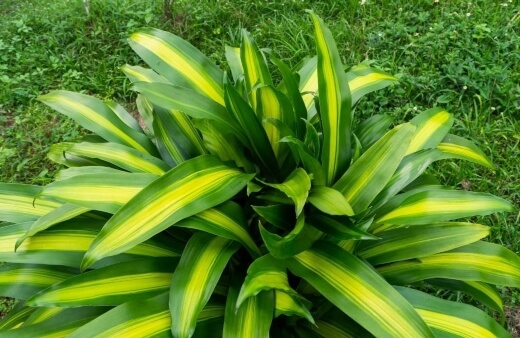
Happy plant, botanically known as Dracaena fragrans ‘Massangeana’, is a flowering plant native throughout tropical Africa, from Sudan south to Mozambique, west to Cote d’Ivoire and southwest to Angola.
It is one of the most popular indoor plants because of its lovely look and health benefits. This plant is one of the best air purifying houseplants (confirmed by NASA to remove harmful toxins from the air), and dracaena plants are known to absorb lead.
The corn plant as it’s also commonly known, is an evergreen shrub with long, sword-shaped leaves with stripes of golden yellow down the middle. As it ages, the plant tends to drop its lower leaves so that the stem is exposed.
The happy plant was the winner of the prestigious Award of Garden Merit of the Royal Horticultural Society. It grows up to 4.5 metres tall and 1.2 metres wide, enjoying organically rich, well-drained soils in part shade.
Indoors, you can grow the plant in loam-based potting compost in full light with moderate humidity. Keep the soil moist during the growing season, but reduce watering from autumn to late winter.
Drought tolerant, the happy plant tolerates a wide range of indoor temperatures but is best grown in temperatures of 15 to 24°C. It’s great for containers or Mediterranean gardens.
The plant is disease resistant but can be susceptible to scale, mealybugs, and thrips. Propagation of the happy plant is either by semi-hardwood cuttings or leafless stem sections in spring. Keep an eye out for your pets as the happy plant is toxic to dogs, cats and horses.
Popular Cultivars of Dracaena fragrans
Dracaena fragrans ‘Massangeana’This is the most common and popular cultivar, known for its corn yellow stripe that runs through the centre of each leaf. In comparison to the other variegated ones, it has a thinner yellow line and the leaves also tend to be narrower and longer. | 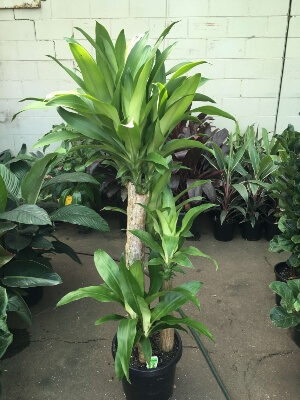 Source: westlakenursery.com.au |
Dracaena fragrans ‘Lindenii’With this cultivar, the corn yellow is found on the edges of the leaves rather than through the centre. It’s easily confused with another houseplant called Dracaena reflexa ‘Variegata’ also known as the Song of India. |  Source: carousell.com.my |
Dracaena fragrans ‘Victoria’This cultivar is very similar to Dracaena fragrans ‘Massangeana’ - the yellow stripe runs through the middle of the leaf, with smaller but wider leaves that are triangular. The yellow corn stripe is also bolder. This is probably the most attractive cultivar as the leaf shape is neater and more compact. However it doesn’t grow quite as fast and is difficult to find commercially. | 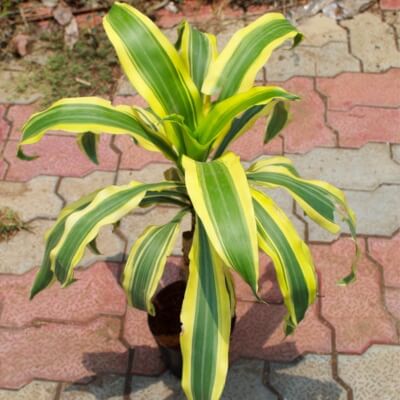 Source: nurserynisarga.in |
Dracaena fragrans ‘Massangeana’

Source: westlakenursery.com.au
This is the most common and popular cultivar, known for its corn yellow stripe that runs through the centre of each leaf. In comparison to the other variegated ones, it has a thinner yellow line and the leaves also tend to be narrower and longer.
Dracaena fragrans ‘Lindenii’

Source: carousell.com.my
With this cultivar, the corn yellow is found on the edges of the leaves rather than through the centre. It’s easily confused with another houseplant called Dracaena reflexa ‘Variegata’ also known as the Song of India.
Dracaena fragrans ‘Victoria’

Source: nurserynisarga.in


Get Your Free Guide:
Master Growing Australian Natives eBook
A Must Have Complete Guide for Every Australian Garden
Get Your Free Guide:
Master Growing Australian Natives eBook
A Must Have Complete Guide for Every Australian Garden
This cultivar is very similar to Dracaena fragrans ‘Massangeana’ - the yellow stripe runs through the middle of the leaf, with smaller but wider leaves that are triangular. The yellow corn stripe is also bolder.
This is probably the most attractive cultivar as the leaf shape is neater and more compact. However it doesn’t grow quite as fast and is difficult to find commercially.
Planting Dracaena fragrans ‘Massangeana’
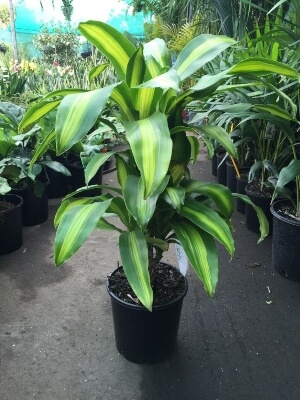
Source: westlakenursery.com.au
Planting Happy Plant Indoors
Happy plant needs a good soil mix that can be mixed with a third of compost. If you want to improve drainage, you can pour clay pebbles or small stones into the pot to form a layer at the bottom. This will help protect the roots from sitting in water which could kill it.
Set up your plant in a fair-sized pot filled with indoor plant or leaf plant soil mix. It might be necessary to repot your happy plant in spring every 2 or 3 years.
How to Plant Happy Plant Outdoors
In the same way that you would prepare your happy plant for a pot, when planting it in the garden, you can place the plant on a bed of gravel, small stones or clay pebbles to drain the water.
On top of this layer you can use a blend of soil mix, garden soil and sand. Happy plant is intolerant to the cold and will only grow outside if the climate is quite warm, with a temperature always higher than 18°C.
How to Grow Happy Plants
Happy plants are one of the best indoor plants - they are so easy to care for and improve air quality. It has thick woody stems and long leaves, which make it look more like a tree than a houseplant.

Sunlight
Happy plants need moderate to bright indirect light indoors. If your plant is outdoors, make sure it is placed in a sheltered spot with shade to semi-shade to protect the leaves from burning.
The plant prefers medium to bright indirect sunlight but can survive in low light situations. If you notice brown spots on the leaves or pale, bleached leaves it usually means the plant is getting too much light.
Leaves that are less variegated, slow growing, and small when producing new growth usually means the plant is not getting enough light.
Best Soil for Happy Plant
The type of soil that is suitable for a happy plant can be chalk, clay, loam, and sand. Soil pH can be acid, alkaline or neutral and the soil should be moist but well-drained.
Temperature & Humidity
The happy plant does best in warm temperatures – the sweet spot is ideally not below 10°C and not over 30°C. Like most indoor plants, happy plants like medium to high humidity.
Low humidity can cause brown patches on the leaves. If this happens, you can increase humidity by misting the plant with water. Keep your plant away from drafts of hot and cold air which can cause damage.
Happy Plant Propagation
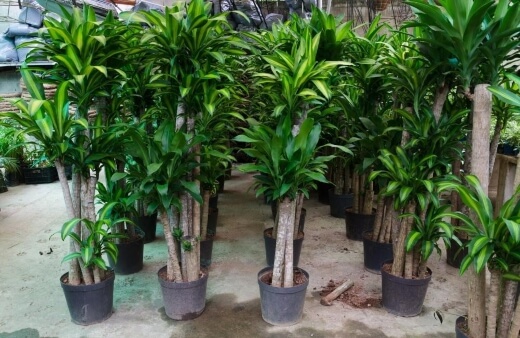
Propagating Happy Plant from Top Cutting
One of the easiest ways to propagate a happy plant is by simply cutting off the top. Snip it just below the leaf line and include at least one node - roots grow from these round, white bumps on the stem.
You can then either plant your cutting in some soil or place it in a vase filled with fresh water. Placing it in water has the added advantage of seeing how the cutting is doing and whether it has rooted yet.
Place the container in a warm spot and wait. Roots and new growth should appear quickly during the warm summer months, but would take a bit longer in winter. If you’re water-propagating, try moving the cutting to soil once the roots are about 2.5 cm.
Propagating Corn Plant from Stem Cuttings
Propagating a happy plant to turn one plant into many is possible using the stem cutting method. As with the top cutting method, snip off the top of the plant and propagate as you usually would.
However, you can also remove as many stem sections as you like - they should be at least 20cm and contain a few nodes. Leave a good section of the original plant so that it can grow back as well.
Place all your stem sections in water or soil. Roots should start appearing at the bottom nodes, while any nodes at the top will start swelling and producing new leaf shoots.
Happy Plant Propagation by Air Layering
Happy plants are great for a propagation method called air layering. This basically involves taking a cutting, but before you do, you trick the plant into developing a root system on the stem.
This process is super easy and all you need is a knife or secateurs, some plastic wrap and some orchid moss. Some rooting hormone is also handy. Sterilise your knife with some alcohol and carefully scrape away a layer of bark on the plant’s stem.
The exposed part can be 1.2 cm wide and go around the whole stem. You are essentially creating a wound. If you have rooting hormone, you can dust it onto the mark you have created. This can help speed up the process.
Wet your orchid moss and wrap it around the wounded part of the stem. Cover it with plastic wrap and secure it in place. Your plant will think it has been planted in soil and should start producing roots.
Once you see new roots inside the plastic wrap, you can remove it and cut the stem just below the rooted part. You now have a brand new and already rooted happy plant. The beheaded stem will soon start sprouting new leaves.
Happy Plant Care Tips
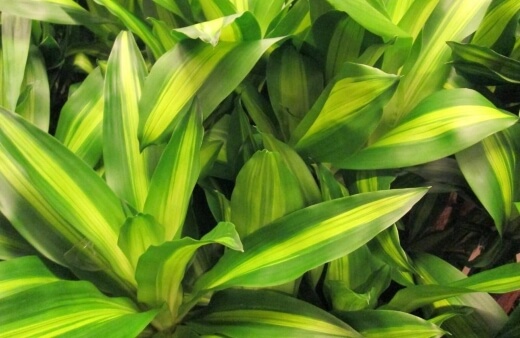
Watering Schedule
Water your happy plant frequently and make sure the soil is evenly moist without becoming soggy. During the colder months, the plant can be watered less often since the soil will retain more water.
Here’s a helpful tip. The top of the soil may look dry but it can be wet underneath, so before watering your plant, dip your finger into the soil to feel the level of moisture.
If it feels soggy, wait for a few days and check again. Water your plant thoroughly and allow the top majority of the soil to dry before watering again. In low light, allow the soil to dry completely before watering.
Water your plant less in winter, when the light levels are lower and growth has slowed down. Overwatering will cause the leaves to turn yellow and fall off and can also cause root rot.
What Fertiliser to Use
Happy plants need very little fertilising. You can feed them once or twice a year in spring and summer with a basic houseplant food diluted to half the recommended strength. Too much fertiliser can cause the leaf tips to burn.
Common Happy Plant Pests and Diseases
Mineral Buildup
If you notice the tips of your Happy Plant turning brown, there might be a mineral buildup in the soil, like salt. You might even see a white layer on the soil. To help get rid of the buildup, you can rinse the plant out under a tap or use distilled water.
Brown or Yellow Leaves
If the leaves start changing colour, you’re either under- or overwatering your plants. Sometimes it can be tricky knowing exactly which one it is. It’s important to keep a close eye on the plant’s soil.
Don’t just water at random. Stick a finger or chopstick into the soil to assess the moisture level first.
Dropped Leaves
You may notice dry leaves dropping from the bottom of your happy plant now and then. This is actually quite a normal process as it's shedding the leaves it no longer needs.
However, if the leaves begin dropping from the top, you might be dealing with pests. Keep an eye out for the usual suspects, like mealybugs, spider mites, and scale. This is also a good time to reassess your watering schedule.
Happy Plant Frequently Asked Questions
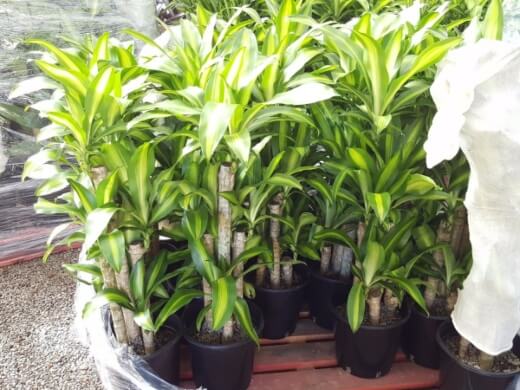
Source: goldengates.com.au
Why is it called a happy plant?
The popular happy plant promises a lot with its name and lives up to it. Happy plants are one of the best indoor plants because they are easy to care for and do an amazing job in improving air quality.
Does a happy plant like humidity?
Natural room humidity is the best option for growing this plant, but aim to keep the humidity levels around 40 to 60 percent.
Is the happy plant toxic to humans and animals?
Happy plant leaves are toxic to pets and humans. If ingested, it will cause mouth and stomach irritation with vomiting.
Why are the leaves of my happy plant turning brown?
This may be caused by chemicals in your tap water. Try to use filtered water, or leave tap water in an open container overnight to allow some of the chemicals to evaporate.
Why not sign up for our newsletter for tips, tools and garden treats of every kind. When you join, you get two free ebooks as a bonus.
For more indoor plant inspiration, check out our collection of indoor plant articles, to help you make the right choice for your home. Happy reading (and gardening).
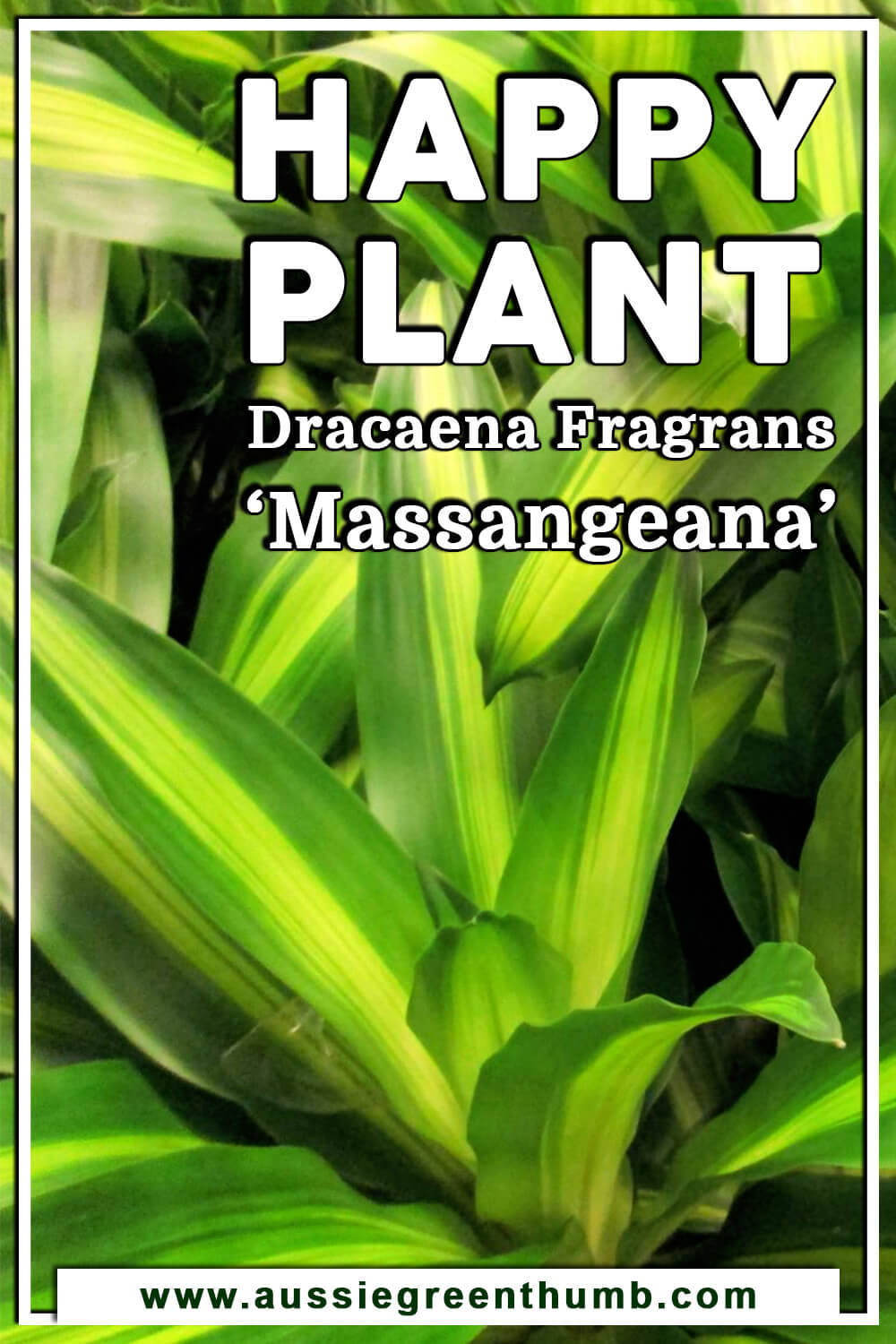
Wrapping Up Our Happy Plant Guide
Looking for a bit of happiness in your life? The happy plant really does live up to its name. It’s happy when you don’t fuss over it, looks great, and will keep your air clean too if you choose to have it indoors.
This shrub can cope with a variety of soils and grows to a good height. It’s pleasing on the eye, no matter where you choose to grow it and propagation is super easy too.
People find that this plant makes a great gift for any occasion – perhaps you can add a happy plant to your go-to gift list as well and bring a little happiness wherever you go.
Published on June 17, 2022 by Maisie Blevins
Last Updated on February 26, 2024




